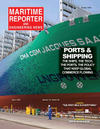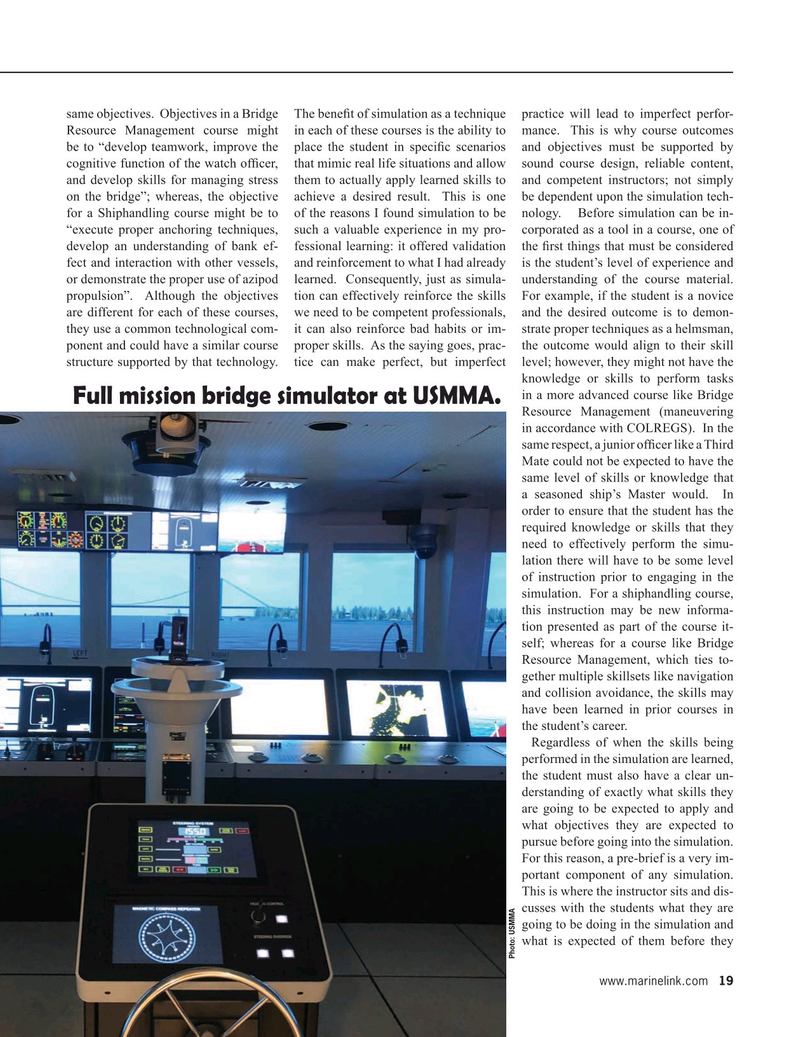
Page 19: of Maritime Reporter Magazine (October 2020)
Shipping & Port Annual
Read this page in Pdf, Flash or Html5 edition of October 2020 Maritime Reporter Magazine
same objectives. Objectives in a Bridge The bene? t of simulation as a technique practice will lead to imperfect perfor-
Resource Management course might in each of these courses is the ability to mance. This is why course outcomes be to “develop teamwork, improve the place the student in speci? c scenarios and objectives must be supported by cognitive function of the watch of? cer, that mimic real life situations and allow sound course design, reliable content, and develop skills for managing stress them to actually apply learned skills to and competent instructors; not simply on the bridge”; whereas, the objective achieve a desired result. This is one be dependent upon the simulation tech- for a Shiphandling course might be to of the reasons I found simulation to be nology. Before simulation can be in- “execute proper anchoring techniques, such a valuable experience in my pro- corporated as a tool in a course, one of develop an understanding of bank ef- fessional learning: it offered validation the ? rst things that must be considered fect and interaction with other vessels, and reinforcement to what I had already is the student’s level of experience and or demonstrate the proper use of azipod learned. Consequently, just as simula- understanding of the course material. propulsion”. Although the objectives tion can effectively reinforce the skills For example, if the student is a novice are different for each of these courses, we need to be competent professionals, and the desired outcome is to demon- they use a common technological com- it can also reinforce bad habits or im- strate proper techniques as a helmsman, ponent and could have a similar course proper skills. As the saying goes, prac- the outcome would align to their skill structure supported by that technology. tice can make perfect, but imperfect level; however, they might not have the knowledge or skills to perform tasks in a more advanced course like Bridge
Full mission bridge simulator at USMMA.
Resource Management (maneuvering in accordance with COLREGS). In the same respect, a junior of? cer like a Third
Mate could not be expected to have the same level of skills or knowledge that a seasoned ship’s Master would. In order to ensure that the student has the required knowledge or skills that they need to effectively perform the simu- lation there will have to be some level of instruction prior to engaging in the simulation. For a shiphandling course, this instruction may be new informa- tion presented as part of the course it- self; whereas for a course like Bridge
Resource Management, which ties to- gether multiple skillsets like navigation and collision avoidance, the skills may have been learned in prior courses in the student’s career.
Regardless of when the skills being performed in the simulation are learned, the student must also have a clear un- derstanding of exactly what skills they are going to be expected to apply and what objectives they are expected to pursue before going into the simulation.
For this reason, a pre-brief is a very im- portant component of any simulation.
This is where the instructor sits and dis- cusses with the students what they are going to be doing in the simulation and what is expected of them before they
Photo: USMMA www.marinelink.com 19
MR #10 (18-33).indd 19 10/6/2020 8:43:06 AM

 18
18

 20
20
